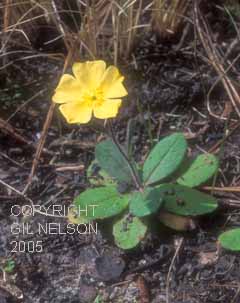Crocanthemum carolinianum
| Crocanthemum carolinianum | |
|---|---|

| |
| Photo was taken by Gil Nelson | |
| Scientific classification | |
| Kingdom: | Plantae |
| Division: | Magnoliophyta - Flowering plants |
| Class: | Magnoliopsida – Dicotyledons |
| Order: | Violales |
| Family: | Cistaceae |
| Genus: | Crocanthemum |
| Species: | C. carolinianum |
| Binomial name | |
| Crocanthemum carolinianum (Walter) Michx. | |

| |
| Natural range of Crocanthemum carolinianum from USDA NRCS Plants Database. | |
Common names: Carolina frostweed; Carolina sunrose
Contents
Taxonomic notes
Synonym: Helianthemum carolinianum (Walter) Michaux[1]
Varieties: none[1]
Description
Generally, for the Crocanthemum genus, they are erect perennials with alternate, pubescent leaves. There are two types of flowers, chasmogamous and cleistogamous. Chasmogamous flowers are on the pedicels that elongate to usually more than 1 cm long with large showy, tallow petals; there are numerous stamens and large sepals. The cleistogamous flowers are on the pedicels are usually less than 3 mm long, where the petals are absent, the stamens are few and the sepals are smaller than those of the chasmogamous flowers. The sepals are in 2 whorls, the outer are narrower than the inner. The capsule is 3-locular.[2]
Specifically, for Crocanthemum carolinianum species, the roots have tuberous thickenings, the stems grow 10 - 30 cm tall, are pilose, and arise from a basal rosettes of leaves. The leaves are widely elliptic to obovate, or nearly lanceolate, growing 2 - 5 cm long, and 0.7 - 2 cm wide, pubescent on both surfaces, with longer trichomes above; the basal leaves are often somewhat irregular, usually larger than the stem leaves; the petioles grow 1 - 3 mm long. The cleistogamous flowers are absent. The chasmogamous flowers are solitary, are opposite a leaf (or appearing internodal). There are 6 sepals, the outer 3 linear, growing 5 - 10 mm long, are acute to acuminate, and pubescent; the petals grow 1.5 - 2 cm long. The capsules are round, growing 7 - 9 mm long. The seeds are reddish black in color, papillose, and growing 0.8 - 1 mm long.[2]
Crocanthemum carolinianum does not have specialized underground storage units apart from its fibrous roots.[3] Diaz-Toribio and Putz (2021) recorded this species to have a water content of 60.5% (ranking 58 out of 100 species studied).[3]
Distribution
This species is native to the Gulf Coastal Plain, ranging from northeast North Carolina to south Florida and west to east Texas and Arkansas.[1]
Ecology
Habitat
C. carolinianum can be found in longleaf pine-wiregrass savannas and dry pine flatwoods, as well as some disturbed areas, like mowed areas and fields.[4] This is an indicator species of the North Florida subxeric sandhills community.[5] It grows well in sunny, well drained habitats.[6] It has also been found to grow near active gopher tortoise mounds.[4] While it is an upland species, it occurs in hydric and non-hydric ecotones as well as upland transect zones.[7]
Phenology
C. carolinianum has both chasmogamous flowers and cleistogamous flowers. The chasmogamous flowers have 5 petals and numerous stamen, while the cleistogamous flowers lack petals and have few stamen.[8] Flowering has been observed in February, March, and April.[4] However, common flowering time is between April and May as well as between July and August.[1]
Fire ecology
This species occurs in habitat that burns frequently[4] as evidenced by populations of Crocanthemum carolinianum that have been known to persist through repeated annual burns on the Pebble Hill plantation in north Florida.[9]
Conservation, cultivation, and restoration
This species is listed as critically imperiled and has a state rank of S1 in North Carolina.[10]
Cultural use
Photo Gallery
References and notes
- ↑ 1.0 1.1 1.2 1.3 Weakley, A.S. 2020. Flora of the Southeastern United States. Edition of 20 October 2020. University of North Carolina at Chapel Hill, Chapel Hill, North Carolina.
- ↑ 2.0 2.1 Radford, Albert E., Harry E. Ahles, and C. Ritchie Bell. Manual of the Vascular Flora of the Carolinas. 1964, 1968. The University of North Carolina Press. 718-9. Print.
- ↑ 3.0 3.1 Diaz-Toribio, M.H. and F. E. Putz 2021. Underground carbohydrate stores and storage organs in fire-maintained longleaf pine savannas in Florida, USA. American Journal of Botany 108: 432-442.
- ↑ 4.0 4.1 4.2 4.3 Florida State University Robert K. Godfrey Herbarium database. URL: http://herbarium.bio.fsu.edu. Last accessed: June 2014. Collectors: Robert K. Godfrey, Chris Cooksey, R. Komarek, Loran C. Anderson, and Richard R. Clinebell II. States and Counties: Florida: Leon. Georgia: Grady and Thomas.
- ↑ Carr, S. C., et al. (2010). "A Vegetation Classification of Fire-Dependent Pinelands of Florida." Castanea 75(2): 153-189.
- ↑ [[1]]Native Florida Wildflowers. Accessed: April 16, 2016
- ↑ Kirkman, L. K., et al. (1998). "Ecotone characterization between upland longleaf pine/wiregrass stands and seasonally-ponded isolated wetlands." Wetlands 18(3): 346-364.
- ↑ [[2]]Native Plants of the Carolinas and Georgia. Accessed: April 16, 2016
- ↑ Robertson, K.M. Unpublished data collected from Pebble Hill Fire Plots, Pebble Hill Plantation, Thomasville, Georgia.
- ↑ [[3]] NatureServe Explorer. Accessed: April 22, 2019.